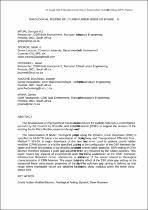JavaScript is disabled for your browser. Some features of this site may not work without it.
- ResearchSpace
- →
- Research Publications/Outputs
- →
- Conference Publications
- →
- View Item
| dc.contributor.author |
Mturi, George AJ

|
|
| dc.contributor.author |
Zoorob, SE

|
|
| dc.contributor.author |
O'Connell, Johannes S

|
|
| dc.contributor.author |
Anochie-Boateng, Joseph

|
|
| dc.contributor.author |
Maina, J

|
|
| dc.date.accessioned | 2011-08-29T13:11:03Z | |
| dc.date.available | 2011-08-29T13:11:03Z | |
| dc.date.issued | 2011-08 | |
| dc.identifier.citation | Mturi, GAJ, Zoorob, SE, O’Connell, J, et al. 2011. Rheological testing of crumb rubber modified bitumen. 7th International Committee on Road & Airfield Pavement Technology (ICPT), Thailand, 3-5 August 2011, pp. 8pp | en_US |
| dc.identifier.uri | http://hdl.handle.net/10204/5136 | |
| dc.description | 7th International Committee on Road & Airfield Pavement Technology (ICPT), Thailand, 3-5 August 2011 | en_US |
| dc.description.abstract | The development of improved test protocols and procedures for asphalt materials is currently been pursued by the Council for Scientific and Industrial Research (CSIR) to support the revision of the existing South Africa flexible pavement design method. The determination of binder rheological properties using the dynamic shear rheometer (DSR) is specified in AASHTO (American Association of State Highway and Transportation Officials) Test Method T 315-05. A major draw-back of this test method when used to analyse crumb rubber modified (CRM) bitumen is that the specified gap setting in the configuration of the DSR between the upper and lower test platens is too small to accommodate crumb rubber particles. DSR testing of CRM bitumen therefore requires a plate gap adjustment to avoid any influence by the rubber particles. This paper covers key aspects of experimental work currently being undertaken at the CSIR Transport Infrastructure Research Group laboratories to address some of the issues related to rheological characterisation of CRM bitumen. The paper illustrates the effect of the DSR plate gap setting on the measured linear visco-elastic properties of the sample. The optimum gap setting is defined as that range where repeatable values are obtained for the complex shear modulus within the linear viscoelastic limit. | en_US |
| dc.language.iso | en | en_US |
| dc.relation.ispartofseries | Workflow;6927 | |
| dc.subject | Crumb Rubber Modified Bitumen | en_US |
| dc.subject | Rheological testing | en_US |
| dc.subject | Dynamic shear rheometer | en_US |
| dc.title | Rheological testing of crumb rubber modified bitumen | en_US |
| dc.type | Conference Presentation | en_US |
| dc.identifier.apacitation | Mturi, G. A., Zoorob, S., O'Connell, J. S., Anochie-Boateng, J., & Maina, J. (2011). Rheological testing of crumb rubber modified bitumen. http://hdl.handle.net/10204/5136 | en_ZA |
| dc.identifier.chicagocitation | Mturi, George AJ, SE Zoorob, Johannes S O'Connell, Joseph Anochie-Boateng, and J Maina. "Rheological testing of crumb rubber modified bitumen." (2011): http://hdl.handle.net/10204/5136 | en_ZA |
| dc.identifier.vancouvercitation | Mturi GA, Zoorob S, O'Connell JS, Anochie-Boateng J, Maina J, Rheological testing of crumb rubber modified bitumen; 2011. http://hdl.handle.net/10204/5136 . | en_ZA |
| dc.identifier.ris | TY - Conference Presentation AU - Mturi, George AJ AU - Zoorob, SE AU - O'Connell, Johannes S AU - Anochie-Boateng, Joseph AU - Maina, J AB - The development of improved test protocols and procedures for asphalt materials is currently been pursued by the Council for Scientific and Industrial Research (CSIR) to support the revision of the existing South Africa flexible pavement design method. The determination of binder rheological properties using the dynamic shear rheometer (DSR) is specified in AASHTO (American Association of State Highway and Transportation Officials) Test Method T 315-05. A major draw-back of this test method when used to analyse crumb rubber modified (CRM) bitumen is that the specified gap setting in the configuration of the DSR between the upper and lower test platens is too small to accommodate crumb rubber particles. DSR testing of CRM bitumen therefore requires a plate gap adjustment to avoid any influence by the rubber particles. This paper covers key aspects of experimental work currently being undertaken at the CSIR Transport Infrastructure Research Group laboratories to address some of the issues related to rheological characterisation of CRM bitumen. The paper illustrates the effect of the DSR plate gap setting on the measured linear visco-elastic properties of the sample. The optimum gap setting is defined as that range where repeatable values are obtained for the complex shear modulus within the linear viscoelastic limit. DA - 2011-08 DB - ResearchSpace DP - CSIR KW - Crumb Rubber Modified Bitumen KW - Rheological testing KW - Dynamic shear rheometer LK - https://researchspace.csir.co.za PY - 2011 T1 - Rheological testing of crumb rubber modified bitumen TI - Rheological testing of crumb rubber modified bitumen UR - http://hdl.handle.net/10204/5136 ER - | en_ZA |






